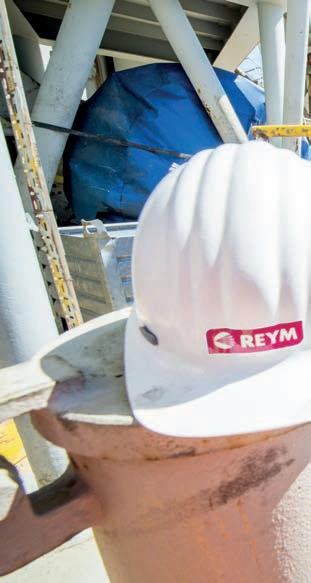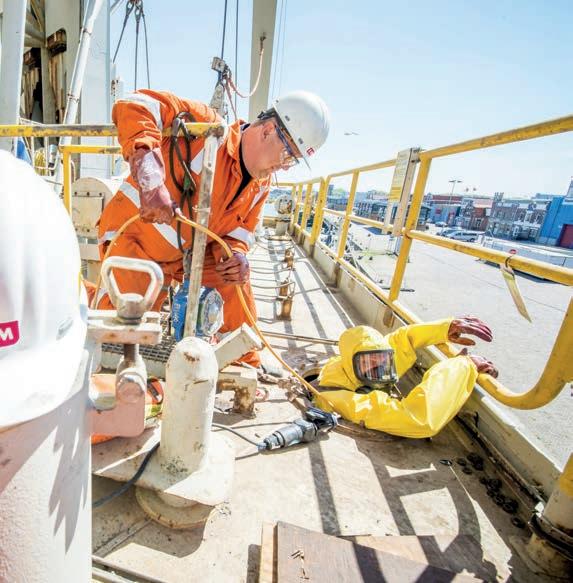
4 minute read
Three gentlemen and a lady
Collect your business guide with a presentaton of your future business partners at the booth of Amsterdam IJmuiden Ofshore Ports
A CONVERSATION ABOUT DECOMMISSIONING AND THE NORTH SEA CANAL REGION
Advertisement
Photo courtesy of Ernie Buts
THE DECOMMISSIONING OF OIL & GAS INFRASTRUCTURE ELEMENTS IS AN ISSUE OF GLOBAL IMPORTANCE THAT HAS A PARTICULAR RESONANCE IN LOCATIONS LIKE THE NORTH SEA CANAL REGION, DUE TO ITS LONG HISTORY OF OFFSHORE INDUSTRY.
With the energy transiton signaling the end of the economic lifespan for many installatons, the Netherlands is facing a major operaton to reuse or disassemble some 160 existng oil & gas platorms on the North Sea. Part of this infrastructure could be used to actually accelerate the energy transiton by utlising platorms and wells for hydrogen producton and CO2 storage. But there’s more. The new wind farms currently built on the North Sea will also have a limited economic lifespan and require dismantling and (partal) recycling in due course.
Despite the complexites involved in decommissioning, there are clearly many opportunites for the North Sea Canal region. Sylvia Boer, Director of Amsterdam IJmuiden Ofshore Ports (AYOP), discusses this potental with Lex de Groot (Managing Director Neptune Energy – the largest oil & gas producer in the Dutch part of the North Sea), Marcel van Leeuwen (CEO of
BOOTH NO. 1.200
OFFSHORE ENERGY AMSTERDAM
Three men and a lady, from left to right: Jurgen Treffers, Sylvia Boer, Lex de Groot, and Marcel van Leeuwen. Last year, Neptune Energy decommissioned three of their platforms.

Photo courtesy of Neptune Energy.

Van Leeuwen Zwanenburg Sloopwerken – a pioneer in a total-care approach to demoliton), and Jurgen Trefers (CFO of KOOLE Contractors – an internatonal industrial and maritme service-and soluton provider specialised in industrial demoliton, remediaton, wreck removal, and maritme constructon). All three are experts that each share their views based upon their line of business. The conversaton also turns to the conditons which need to be met to carry out decommissioning in an efcient and, above all, future-proof manner.
Sylvia: “Gentlemen, what does decommissioning in the North Sea Canal region mean to you?” Lex: “I have a clear vision on this, based upon our work last year with Neptune
Amsterdam is very much on track to becoming a superb port for decommissioning.
Energy decommissioning three of our platorms. Amsterdam-IJmuiden and the North Sea Canal region play an important role in these actvites.”
Jurgen: “Decommissioning ofers an extension of actvites for the port of Amsterdam that has everything in place for the circular economy and waste processing. By working together, we can ofer a total package of solutons throughout the entre process and chain, from inventory to reuse, from the oil majors to steel processors. Indeed, I’m talking here about a sustainable closed circle within an area of just 21km. Amsterdam is very much on track to becoming a superb port for decommissioning.”
Sylvia: “Agreed, Marcel?” Marcel: “Absolutely. All the companies you need, from purifcaton to asbestos removal and demoliton, are available. A wide variety too, so you can work together in a very fexible way. This is a clear beneft.”
At Ofshore Energy 2021, AYOP together with several partners, will introduce DecomMissionBlue. DecomMissionBlue was initated, based on its partners shared ambiton to tackle the growing challenge of dismantling and recycling ofshore, maritme objects & installatons (platorms, ships, windturbines) in an efcient, fast and above all sustainable way. Behind the largest sea lock in the world, a brand-new yard is opened, equipped to work tdal-free and therefore tme efcient. With an ideal geographical locaton in relaton to the North Sea, and the beneft of being able to process all parts and materials within a radius of 15km. DecomMissionBlue stands out by the exceptonal way in which its partners reinforce each other by combining diverse expertses, disciplines, experience and perspectves. Together BK Ingenieurs, Boskalis Nederland, Building Careers, Koole Contractors/Decom Amsterdam, Mammoet, Port of Amsterdam, Reym, Seafox, Tata Steel and VLZS complete the whole value chain.

Sylvia: “Following on from that, do you see concrete opportunities for companies in the region?” Marcel: “Certainly, companies in the western port area are extremely compettve. We have everything in one place, and everyone is certfed. Together we can approach and realise the work far more efciently.”
Lex: “This is in line with how we see things, too. As an operator, we prefer to meet with a single contractor. There are plenty of opportunites ahead if the diferent companies can establish a vision of what is really essental and become atractve as one party. Especially in view of the locaton and the local possibilites.”
Jurgen: “Exactly. And let’s not forget that the market wants to have a choice. Once Amsterdam is up and running, it will be a major compettor for Roterdam. This will beneft the market – which is certainly large enough. We therefore decided to invest in Decom Amsterdam, a state-of-the-art decommissioning dock with 16ha of land and 7ha of deep water in the western port area. This dock has been operatonal since May 2020.”
Sylvia: “Moving on to another subject: the process. How does decommissioning actually work? And is there room for improvement?” Jurgen: “How the physical trajectory will progress is ofen hard to predict. It depends on the circumstances. How much waste is involved? How can the maritme object be brought to shore? Issues like that. But we are contractors, so we accept these risks. We
There’s a lot to be gained from coming together sooner and being more transparent when it comes to plans and developments.
Photo courtesy of Reym.
make an estmate based on the informaton provided and then set the price.”
Marcel: “It’s the same for us. You accept the entre project and make a risk calculaton. You can say no if the risks seem too high, in case of asbestos or Chromium-6, for instance, or you take on the project anyway in open partnership with the client. That’s also an opton.”
Sylvia: “How do you see this as a client, Lex?” Lex: “I think there’s a lot to be gained from coming together sooner and being more transparent when it comes to plans and developments. We are taking steps in this regard as an industry, too. The Nexstep platorm is a good example as it coordinates, facilitates, and accelerates the decommissioning and reuse of the oil & gas infrastructure. For us as a company and in the framework of efciency and cost savings, we prefer to decommission as many platorms at the same tme as possible. Even if that means working with other operators.”
Sylvia: “We will soon be joining Nexstep at the table again. Perhaps AYOP can set up a good partnership concept with them.” Lex: “That sounds like a good idea. Decommissioning ‘the whole country’ is quite the operaton. All in all, it will cost between fve and seven billion euros, so there’s plenty of work to be done.”
Sylvia: “Sounds great, lots of work on the horizon. Would something need to change in the Netherlands or Europe to make decommissioning successful?” Lex: “In general, I think clearer regulatons with predictable outcomes and tmelines could result in signifcant improvements. The NOx issue, for example, is having a major impact for us at sea.”
Marcel: “The entre export and sales mater, and the transport of vessels to cheaper
countries to have them decommissioned there – those are the issues that should be tackled.”
Jurgen: “I think it’s being handled beter than it used to be, but I agree wholeheartedly. In the past years, we’ve seen vessels being sailed onto beaches in developing countries to be dismantled. This should be beter supervised by the European Union. Our aim is to recycle around 98%. I’m prety sure that’s not happening there.”

Sylvia: “From the beach to the port. Which preconditions should the region meet to play a meaningful role in decommissioning?” Jurgen: “I think the region already meets all the preconditons, and then some. All the companies you need are located within a range of 5km and fully certfed. The locks are being widened from 58m to 70m, the logistcs and hinterland are in good shape, and everything can be removed via seaways,
All the companies you need are located within a range of 5km and are fully certifed.
which means a reducton of road transport and hence, CO2 and nitrogen emissions.”
Marcel: “Exactly. And then there’s efciency; if something needs to be partly dismantled and partly adapted, it is only a mater of crossing the water and our neighbour Damen can do this at its shipyard. Everything is ready: BK Ingenieurs for assessing the amount of asbestos, Chromium-6, and other hazardous materials; Boskalis for preparing, removing, and transportng topsides to the demoliton yard; Reym for the cleaning, transport and processing of waste materials for all oil & gas operators on the North Sea; SAB Detachering for supplying engineers to all technical stages of the product lifecycle; and Tata Steel can recycle dismantled steel. Then there’s Amsterdam, which is transforming into a circular port. And that’s just to name a few!”
The combined strength of individual members each having their own expertise is something that AYOP should clearly use as a trump card.
Sylvia: “How can AYOP play a signifcant role in this process?” Marcel: “By making sure that we act together collectvely as a unifed organisaton.”
Jurgen: “The combined strength of individual members each having their own expertse is something that AYOP should clearly use as a trump card. And you should promote Amsterdam as a port that can provide everything people might need, especially regarding decommissioning.”
Lex: “Show us, as operators, that we can fnd the complete service package in Amsterdam. And that we can hand over actvites to reliable partes. I think this would be the perfect task for AYOP!”
i. ayop.com
About AYOP
Amsterdam IJmuiden Ofshore Ports (AYOP) is a dynamic associaton of over 100 companies, regional government bodies, and research/ educaton insttutes actve in ofshore oil & gas and wind energy in the North Sea Canal region. Members have a strong focus on ofshore wind maintenance (including cable logistcs), drilling projects for gas extracton, changes to and maintenance of work vessels and platorms, and the disassembly of ofshore structures and vessels. In other words, AYOP represents the entre ofshore industry chain.
This was the third in a series of conversatons exploring the latest developments in our sector. If there’s a subject you would like to see discussed, please contact Sylvia Boer via sylvia@ayop.com.










